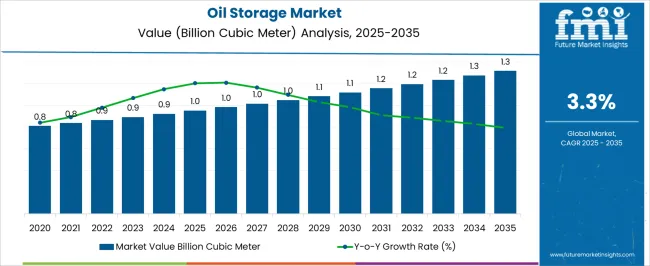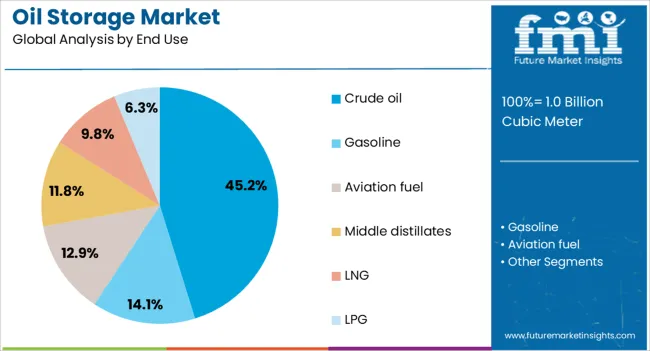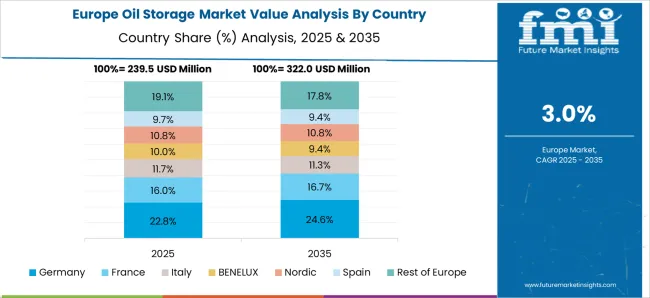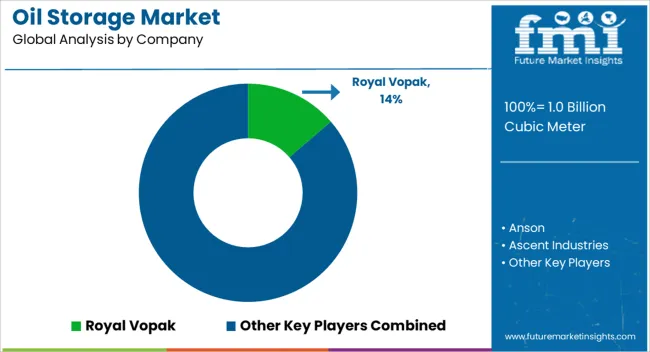The Oil Storage Market is estimated at USD 952 million in 2025 and is projected to reach USD 1.3 billion by 2035, corresponding to a moderate CAGR of 3.3%. Regulatory frameworks play a significant role in shaping market growth, as compliance with environmental, safety, and operational standards directly affects investment, design, and operational practices within the sector. Government mandates related to storage tank integrity, spill prevention, and hazardous material handling drive incremental capital expenditure, influencing overall market expansion. Environmental protection regulations, particularly in Europe and North America, necessitate the adoption of double-walled tanks, leak detection systems, and corrosion-resistant materials, contributing to both cost and compliance-related value.
Similarly, evolving fire and safety codes enforce stricter inspection routines, mandatory certifications, and periodic audits, further impacting operational budgets and long-term market adoption. In developing regions such as Asia-Pacific, regulatory harmonization remains gradual, leading to phased enforcement that moderately restrains rapid market scaling but encourages structured growth aligned with international standards. The emissions and pollution control regulations indirectly affect storage practices by imposing limits on volatile organic compound (VOC) releases and requiring vapor recovery technologies. These requirements incrementally elevate the average selling price and enhance market value, ensuring regulatory compliance becomes an integral component of investment decisions. The market reflects stable growth, where regulatory mandates act as both a guiding framework and a value driver, facilitating the increase from USD 1.0 billion in 2025 to USD 1.3 billion in 2035 while maintaining a consistent, compliance-driven expansion trajectory.

| Metric | Value |
|---|---|
| Oil Storage Market Estimated Value in (2025 E) | USD 952.5 million |
| Oil Storage Market Forecast Value in (2035 F) | USD 1317.9 million |
| Forecast CAGR (2025 to 2035) | 3.3% |
The oil storage market is expanding steadily, propelled by increasing global crude oil production and the need for efficient storage solutions in upstream and downstream operations. The demand for safe and reliable storage infrastructure has been heightened by fluctuations in crude oil supply and geopolitical factors influencing market dynamics.
Advances in tank design and materials have improved the safety, durability, and environmental compliance of storage facilities. Growing investments in energy infrastructure, including refinery expansions and strategic petroleum reserves, have further driven market growth.
Additionally, operational efficiencies and regulatory standards are prompting the replacement or upgrade of aging storage assets. Looking forward, the market is expected to grow as crude oil production scales to meet rising energy demands. Segment growth is anticipated to be led by fixed roof storage tanks, favored for their simplicity and cost-effectiveness, and crude oil as the primary end use due to its central role in the energy sector.
The oil storage market is segmented by product, end use, and region.
By Product: The market is divided into fixed roof, floating roof, spherical, and others. Among these, fixed roof tanks are projected to hold the largest share (39.8% in 2025) due to their simple design, cost-effectiveness, and reliability in large-scale storage applications.
By End Use: The market is classified into crude oil, gasoline, aviation fuel, middle distillates, LNG, and LPG. Crude oil leads the segment with a 45.2% share in 2025, reflecting its critical role in strategic reserves and refining operations.
By Region: Regionally, the market is categorized into North America, Latin America, Western Europe, Eastern Europe, Balkan & Baltic Countries, Russia & Belarus, Central Asia, East Asia, South Asia & Pacific, and the Middle East & Africa. China and India are among the fastest-growing markets, while North America and Europe remain steady due to regulatory compliance and infrastructure upgrades.

The fixed roof tank segment is projected to hold 39.8% of the oil storage market revenue in 2025, maintaining its lead among product types. These tanks are favored for their robust construction and cost efficiency in storing large volumes of oil under stable conditions.
Their simple design reduces maintenance needs and is suitable for facilities with minimal vapor loss concerns. Fixed roof tanks are commonly deployed in refineries, terminals, and storage depots where operational reliability is paramount.
The segment benefits from widespread acceptance and proven performance in various climates. As infrastructure projects continue, fixed roof tanks remain a preferred option for economical and effective storage solutions.

The crude oil segment is expected to account for 45.2% of the oil storage market revenue in 2025, reflecting its dominance as the primary stored product. The segment’s growth is driven by expanding crude oil production worldwide and the necessity for strategic storage to manage supply-demand imbalances.
Storage facilities for crude oil are critical for maintaining buffer stocks, supporting refining operations, and enabling export-import activities. Increased exploration and production activities in emerging markets have further boosted crude oil storage capacity.
As energy consumption rises and supply chains grow more complex, the demand for reliable crude oil storage continues to rise, sustaining the segment’s leading position.
The oil storage market has been expanding due to increasing global demand for crude oil, refined petroleum products, and industrial lubricants. Oil storage facilities, including tanks, terminals, and depots, have been widely utilized to manage supply, ensure energy security, and stabilize prices. Market growth has been supported by advances in storage tank design, corrosion resistance, and automated monitoring systems. Rising industrial activity, strategic petroleum reserves, and growth in transportation and energy sectors have further strengthened the adoption of oil storage solutions globally.
The growing need for energy security and supply reliability has been a major driver of the oil storage market. Governments and private operators have increasingly invested in crude oil and petroleum product storage to mitigate the impact of supply disruptions, price volatility, and geopolitical risks. Large-scale storage terminals, tank farms, and strategic petroleum reserves have been constructed to maintain consistent availability for industrial, transportation, and power generation sectors. Automation in monitoring levels, pressure, and temperature has improved operational efficiency and safety. The storage of refined fuels, lubricants, and specialty oils has also expanded to meet industrial and commercial requirements. Rising global energy consumption and the critical role of oil in transportation and manufacturing have reinforced the importance of reliable storage infrastructure worldwide.
Technological innovations in materials, construction, and monitoring have significantly improved the efficiency and safety of oil storage systems. High-strength steel, corrosion-resistant coatings, and floating roof tank designs have been widely adopted to prevent leakage, evaporation losses, and environmental contamination. Integration of sensors, IoT-enabled monitoring, and automated control systems has enabled real-time tracking of inventory, temperature, and pressure, enhancing operational reliability. Innovations in secondary containment, fire suppression, and environmental protection technologies have strengthened compliance with safety and environmental regulations. Modular and prefabricated storage tanks have facilitated rapid deployment in remote and industrial regions. These advancements have increased the lifespan, reliability, and efficiency of storage facilities, supporting continuous oil supply and meeting growing global demand in energy and industrial sectors.
Compliance with environmental, safety, and operational regulations has played a critical role in shaping the oil storage market. Operators must adhere to guidelines for emissions, leak prevention, fire safety, and hazardous material handling. Storage tanks and depots are designed to meet national and international standards for corrosion resistance, spill containment, and emergency response preparedness. Environmental considerations, such as minimizing vapor emissions, controlling soil contamination, and preventing water pollution, have influenced design and operational practices. Regular inspections, monitoring, and reporting have been mandated to maintain safety and regulatory compliance. These factors have driven adoption of advanced storage technologies and infrastructure upgrades, ensuring reliable oil storage while reducing environmental risks and promoting operational efficiency across the sector.
Rapid industrialization, growing energy consumption, and the expansion of transportation and power generation sectors have created significant opportunities for the oil storage market. Emerging economies are investing in new storage terminals, pipelines, and distribution networks to support refining, petrochemical production, and energy distribution. The shift toward strategic storage for crude oil and refined products to stabilize market supply and reduce reliance on imports has increased demand for advanced storage solutions. Integration of renewable fuels, biofuels, and alternative petroleum products into storage infrastructure has also expanded the market. As energy demand continues to rise globally, investments in modern, secure, and efficient oil storage facilities are expected to grow, ensuring continuity of supply and operational resilience for industrial and energy sectors worldwide.

The market is expected to grow at a CAGR of 3.3% between 2025 and 2035, driven by increased energy storage requirements, modernization of tank infrastructure, and strategic petroleum reserves management. China is projected to lead with a 4.5% CAGR, supported by expansion in industrial storage facilities and national energy security initiatives. India follows at 4.1%, with growth fueled by rising crude oil imports and storage capacity enhancements. Germany, at 3.8%, benefits from advanced storage technologies and regulatory compliance for energy reserves. The UK, growing at 3.1%, focuses on upgrading aging infrastructure, while the USA, at 2.8%, experiences steady demand through strategic and commercial storage projects. This report includes insights on 40+ countries; the top markets are shown here for reference.
The industry in China is projected to grow at a CAGR of 4.5% from 2025 to 2035, driven by the expansion of crude oil refining capacity and strategic petroleum reserve initiatives. Investments in large-scale tank farms and logistics infrastructure are enhancing storage efficiency across coastal and inland refineries. Rising industrial fuel consumption and import reliance are boosting demand for both onshore and underground storage solutions. Technological adoption such as automated monitoring and leak detection systems is improving safety and operational efficiency. Strategic partnerships between state-owned and private companies are optimizing storage network utilization and capacity planning.
The industry in India is expected to grow at a CAGR of 4.1% from 2025 to 2035, supported by increasing refinery throughput and growing petroleum product consumption. Expansion of public and private storage terminals is addressing supply chain bottlenecks, particularly in the western and eastern coastal regions. Government incentives for energy security and storage modernization are boosting adoption of advanced tank designs. Rising demand for diesel, gasoline, and LPG is stimulating investment in bulk storage and distribution networks. Strategic collaborations with international storage technology providers are enhancing operational reliability and safety.

Germany is forecast to grow at a CAGR of 3.8% between 2025 and 2035, driven by strategic reserves and commercial fuel storage needs. Investments in state-of-the-art tank farms and digital monitoring systems are enhancing safety and efficiency. Increasing energy import volumes and industrial demand for refined products are influencing capacity expansion. Partnerships between energy companies and technology providers are supporting modernization initiatives and compliance with environmental standards. Storage facilities are increasingly optimized for integration with pipelines and transport networks to ensure continuous supply.
The United Kingdom industry is anticipated to expand at a CAGR of 3.1% over 2025 to 2035, supported by upgrades in existing terminals and coastal storage infrastructure. Energy import dependency and refined fuel demand are major drivers. New investments are focused on automation, safety systems, and environmental compliance. Storage operators are modernizing tank farms to support both crude and refined petroleum products. Collaborative projects between government bodies and private players are enhancing operational efficiency and capacity planning.

The industry in the United States is projected to grow at a CAGR of 2.8% from 2025 to 2035, driven by commercial and strategic storage demand. Expansion of inland and coastal terminals is improving supply chain resilience. The adoption of automated monitoring and leak detection technologies is enhancing operational efficiency and safety compliance. Increasing petroleum imports and refinery outputs are influencing storage network expansion. Collaborative strategies between energy companies are optimizing storage capacity and distribution logistics.

The market is shaped by global demand for safe, efficient, and large-scale storage solutions across refineries, terminals, and distribution networks. Royal Vopak stands as a dominant global player, offering terminal services and advanced storage solutions with a focus on operational reliability and capacity optimization.
CST Industries and Snyder Industries provide modular and steel tank solutions designed for versatility across industrial and commercial applications. Anson and Ascent Industries emphasize customized storage systems for crude oil, petroleum products, and chemicals, catering to both onshore and offshore needs.
Elixir Pro Engineering Solutions and ERGIL leverage engineering expertise to deliver corrosion-resistant and climate-adapted storage tanks. Fisher Tank and LF Manufacturing integrate design flexibility with safety compliance, addressing high-volume storage requirements in emerging regions. NOV and SHAWCOR focus on engineering and pipeline-integrated storage systems, providing end-to-end solutions from construction to maintenance.
| Item | Value |
|---|---|
| Quantitative Units | Million |
| Product | Fixed roof, Floating roof, Spherical, and Others |
| End Use | Crude oil, Gasoline, Aviation fuel, Middle distillates, LNG, and LPG |
| Regions Covered | North America, Europe, Asia-Pacific, Latin America, Middle East & Africa |
| Country Covered | United States, Canada, Germany, France, United Kingdom, China, Japan, India, Brazil, South Africa |
| Key Companies Profiled | Royal Vopak, Anson, Ascent Industries, CST Industries, Elixir Pro Engineering Solutions, ERGIL, Fisher Tank, LF Manufacturing, NOV, Roth Industries, SHAWCOR, Snyder Industries, Superior Tank, T BAILEY, and Waterford Tank & Fabrication |
| Additional Attributes | Dollar sales by storage type and end-use industry, demand dynamics across petroleum, chemical, and renewable oil sectors, regional trends in tank deployment across North America, Europe, and Asia-Pacific, innovation in corrosion-resistant materials, modular tank designs, and automated monitoring systems, environmental impact of leak prevention, emissions control, and end-of-life recycling, and emerging use cases in biofuel storage, offshore platform integration, and smart inventory management solutions. |
The global oil storage market is estimated to be valued at USD 1.0 billion cubic meter in 2025.
The market size for the oil storage market is projected to reach USD 1.3 billion cubic meter by 2035.
The oil storage market is expected to grow at a 3.3% CAGR between 2025 and 2035.
The key product types in oil storage market are fixed roof, floating roof, spherical and others.
In terms of end use, crude oil segment to command 45.2% share in the oil storage market in 2025.






Our Research Products

The "Full Research Suite" delivers actionable market intel, deep dives on markets or technologies, so clients act faster, cut risk, and unlock growth.

The Leaderboard benchmarks and ranks top vendors, classifying them as Established Leaders, Leading Challengers, or Disruptors & Challengers.

Locates where complements amplify value and substitutes erode it, forecasting net impact by horizon

We deliver granular, decision-grade intel: market sizing, 5-year forecasts, pricing, adoption, usage, revenue, and operational KPIs—plus competitor tracking, regulation, and value chains—across 60 countries broadly.

Spot the shifts before they hit your P&L. We track inflection points, adoption curves, pricing moves, and ecosystem plays to show where demand is heading, why it is changing, and what to do next across high-growth markets and disruptive tech

Real-time reads of user behavior. We track shifting priorities, perceptions of today’s and next-gen services, and provider experience, then pace how fast tech moves from trial to adoption, blending buyer, consumer, and channel inputs with social signals (#WhySwitch, #UX).

Partner with our analyst team to build a custom report designed around your business priorities. From analysing market trends to assessing competitors or crafting bespoke datasets, we tailor insights to your needs.
Supplier Intelligence
Discovery & Profiling
Capacity & Footprint
Performance & Risk
Compliance & Governance
Commercial Readiness
Who Supplies Whom
Scorecards & Shortlists
Playbooks & Docs
Category Intelligence
Definition & Scope
Demand & Use Cases
Cost Drivers
Market Structure
Supply Chain Map
Trade & Policy
Operating Norms
Deliverables
Buyer Intelligence
Account Basics
Spend & Scope
Procurement Model
Vendor Requirements
Terms & Policies
Entry Strategy
Pain Points & Triggers
Outputs
Pricing Analysis
Benchmarks
Trends
Should-Cost
Indexation
Landed Cost
Commercial Terms
Deliverables
Brand Analysis
Positioning & Value Prop
Share & Presence
Customer Evidence
Go-to-Market
Digital & Reputation
Compliance & Trust
KPIs & Gaps
Outputs
Full Research Suite comprises of:
Market outlook & trends analysis
Interviews & case studies
Strategic recommendations
Vendor profiles & capabilities analysis
5-year forecasts
8 regions and 60+ country-level data splits
Market segment data splits
12 months of continuous data updates
DELIVERED AS:
PDF EXCEL ONLINE
Oil & Gas Carbon Capture and Storage Market Size and Share Forecast Outlook 2025 to 2035
Oily Waste Can Market Size and Share Forecast Outlook 2025 to 2035
Oil and Gas Seal Market Size and Share Forecast Outlook 2025 to 2035
Oil Coalescing Filter Market Size and Share Forecast Outlook 2025 to 2035
Oil-immersed Iron Core Series Reactor Market Size and Share Forecast Outlook 2025 to 2035
Oil and Gas Sensor Market Forecast Outlook 2025 to 2035
Oil Packing Machine Market Forecast and Outlook 2025 to 2035
Oil and Gas Pipeline Coating Market Forecast and Outlook 2025 to 2035
Oilfield Scale Inhibitor Market Size and Share Forecast Outlook 2025 to 2035
Oil-in-Water Anionic Emulsifier Market Size and Share Forecast Outlook 2025 to 2035
Oil and Gas Field Services Market Size and Share Forecast Outlook 2025 to 2035
Storage Water Heater Market Size and Share Forecast Outlook 2025 to 2035
Oil Control Shampoo Market Size and Share Forecast Outlook 2025 to 2035
Oil Expellers Market Size and Share Forecast Outlook 2025 to 2035
Oilfield Stimulation Chemicals Market Size and Share Forecast Outlook 2025 to 2035
Oiler Kits Market Size and Share Forecast Outlook 2025 to 2035
Oil Pressure Sensor Market Size and Share Forecast Outlook 2025 to 2035
Oil Filled Power Transformer Market Size and Share Forecast Outlook 2025 to 2035
Oily Skin Control Products Market Analysis - Size and Share Forecast Outlook 2025 to 2035
Oil Immersed Shunt Reactor Market Size and Share Forecast Outlook 2025 to 2035

Thank you!
You will receive an email from our Business Development Manager. Please be sure to check your SPAM/JUNK folder too.
Chat With
MaRIA